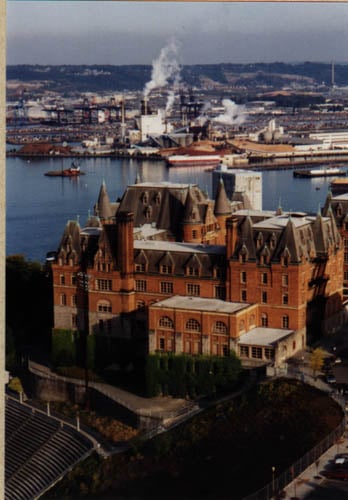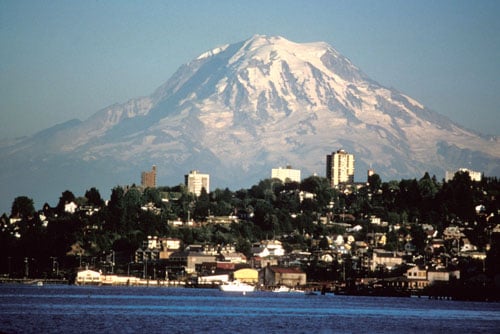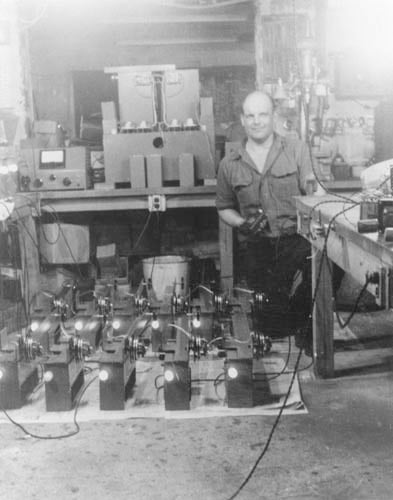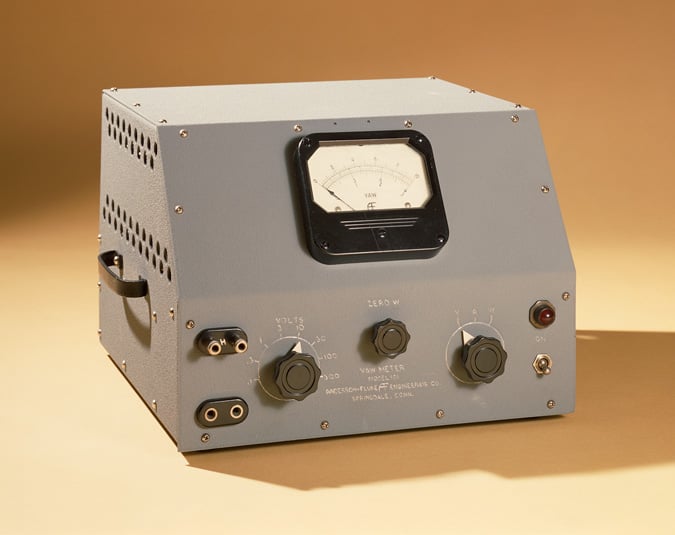Today's Fluke Corporation is a sophisticated, diversified company with an international reputation. How did this big-time company, with down-home values, come to be located in small-town Everett, Washington? It's all about coming home…

John M. Fluke was born December 14, 1911 in Tacoma, Washington, a gritty timber and railroad town ironically surrounded by the natural beauty of Puget Sound and the Cascade mountains. The industrial side of Tacoma would pique John's intellectual curiosity, while its beauty would ultimately lead him back home.
At Washington Elementary (1916 to 1922), the classroom offered a panoramic view of the Cascades to the east and of Puget Sound and Seattle to the north. John would prove to be a scientific whiz-kid. He was fascinated by the General Electric locomotives that pulled Milwaukee Railroad trains over the Cascade Mountains into Tacoma. These 4000-horsepower marvels ran on 3000 volt dc, could win a tug-of-war with a steam engine, did not freeze up in the mountains, and used regenerative braking to recover 40 to 60 percent of the power used to climb a grade on the following downgrade. They also sparked John's interest in electrical engineering.
John attended Tacoma's Stadium High School, originally built by the Northern Pacific Railroad as a French chateau-style hotel. From the school's commanding viewpoint, to the north, he could see the western terminus of the Milwaukee railroad. And looking east John could see, lording over all, majestic Mount Rainier. John graduated from Stadium in 1928, but he never left the Northwest behind.
Two years later, John entered the University of Washington. The central promenade at the University of Washington, Rainier Vista, is rifle-sited at Mt. Rainier. John graduated in 1935 with a BSEE degree, a commission as a Naval ROTC Ensign, and the heart of one Lyla Schram. They would marry in 1937 and be blessed with three children, Virginia, John Jr., and David.

Jobs were scarce, so John entered the Massachusetts Institute of Technology. His classmates included Bill Hewlett, later a founding partner of HP. John graduated with an MSEE in 1936 and joined General Electric in Schenectady, New York. Here he formed a lasting friendship with David Packard, who would later become the other partner in HP.
In 1941, with World War II threatening, Ensign Fluke was called up to the Navy Bureau of Ships to solve difficult shipboard electrical problems for Hyman Rickover (later Admiral Rickover, father of the "nuclear navy"). Commander Fluke was discharged 1946 and turned down opportunities at the Navy and GE to begin a private engineering practice.

One of his clients, American Machine and Foundry (AMF), had introduced an automated pinsetter in 1946. This initial model was unreliable in daily operation, and John was one of the engineers retained to refine the design. John was co-inventor on eight patents, which led to the commercial re-introduction of the AMF "Pinspotter" in 1952.
The royalties on the pinsetter patents provided the seed capital for the formation of the John Fluke Engineering Company in the basement of his Springdale, Connecticut home. In 1948 Fluke had two employees, its first product was the Model 101 VAW meter (volts amps watts), and its first customer was General Electric. Driven by excellence in design, meticulous manufacturing, and the rapid growth in solid-state electronic products, Fluke's Test and Measurement business quickly outgrew the basement. David Packard tried to entice Fluke to move to Palo Alto, near Stanford University, but John announced that he "just wanted to move home."

1952: Fluke Engineering, with six employees, came home to Seattle, to a one-time cabinet shop near the Lake Washington Ship Canal.
1953: Fluke Engineering became a corporation, John Fluke Manufacturing, Inc.
1962: Fluke moved to a purpose-built office and factory in Mountlake Terrace, just north of Seattle.
1981: Fluke moved to its present-day headquarters in Everett, Washington. Carefully folded into a mature Douglas fir forest, the new building was accented by huge rhododendrons that Fluke acquired from the personal collection of famed hybridizer Joy Harold Clarke.
Throughout his Fluke career, "Senior" was:
- a consummate inventor and engineer. He hired others like himself from the University of Washington, Stanford and MIT to develop revolutionary test and measurement products.
- a defender of free enterprise. He served as civilian chairman of a blue-ribbon panel under Department of Defense Secretary Melvin Laird, and Fluke was one of the first US companies to do business in China in 1973.
- a friend of education. He endowed a professorship in manufacturing engineering, and was a major contributor to the Washington Technology Center at the University of Washington, today known as Fluke Hall.
John M. Fluke died February 11, 1984. The stern, outspoken, highly-principled Commander left a legacy of values that every Fluke employee lives by today:
- User safety is Job One. Each Fluke product is designed and tested to exceed international safety standards by wide margins.
- Fluke equipment is trustworthy. It is rugged, reliable and accurate.
- "The customer should always get more than they thought they paid for." Product, support, and service should always exceed customer expectations.
Fluke has grown far beyond the power meters and differential voltmeters of the original company. Today's line includes digital multimeters, calibrators, thermal imagers, process calibrators, handheld oscilloscopes, and network maintenance tools. It all exists because a tech-savvy kid wanted to build a business, and he wanted to come home.